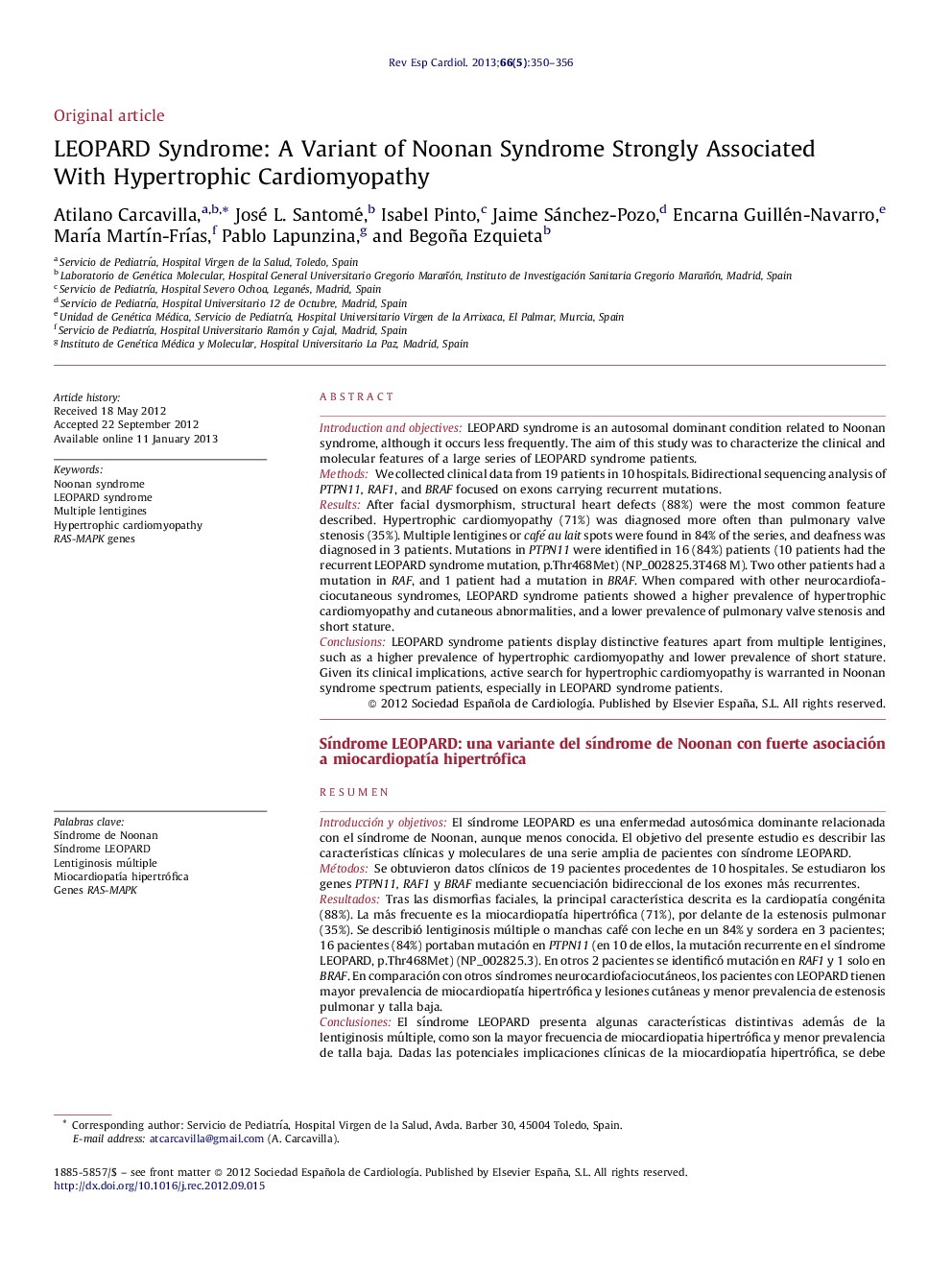| Article ID | Journal | Published Year | Pages | File Type |
|---|---|---|---|---|
| 3017968 | Revista Española de Cardiología (English Edition) | 2013 | 7 Pages |
Introduction and objectivesLEOPARD syndrome is an autosomal dominant condition related to Noonan syndrome, although it occurs less frequently. The aim of this study was to characterize the clinical and molecular features of a large series of LEOPARD syndrome patients.MethodsWe collected clinical data from 19 patients in 10 hospitals. Bidirectional sequencing analysis of PTPN11, RAF1, and BRAF focused on exons carrying recurrent mutations.ResultsAfter facial dysmorphism, structural heart defects (88%) were the most common feature described. Hypertrophic cardiomyopathy (71%) was diagnosed more often than pulmonary valve stenosis (35%). Multiple lentigines or café au lait spots were found in 84% of the series, and deafness was diagnosed in 3 patients. Mutations in PTPN11 were identified in 16 (84%) patients (10 patients had the recurrent LEOPARD syndrome mutation, p.Thr468Met) (NP_002825.3T468 M). Two other patients had a mutation in RAF, and 1 patient had a mutation in BRAF. When compared with other neurocardiofaciocutaneous syndromes, LEOPARD syndrome patients showed a higher prevalence of hypertrophic cardiomyopathy and cutaneous abnormalities, and a lower prevalence of pulmonary valve stenosis and short stature.ConclusionsLEOPARD syndrome patients display distinctive features apart from multiple lentigines, such as a higher prevalence of hypertrophic cardiomyopathy and lower prevalence of short stature. Given its clinical implications, active search for hypertrophic cardiomyopathy is warranted in Noonan syndrome spectrum patients, especially in LEOPARD syndrome patients.
ResumenIntroducción y objetivosEl síndrome LEOPARD es una enfermedad autosómica dominante relacionada con el síndrome de Noonan, aunque menos conocida. El objetivo del presente estudio es describir las características clínicas y moleculares de una serie amplia de pacientes con síndrome LEOPARD.MétodosSe obtuvieron datos clínicos de 19 pacientes procedentes de 10 hospitales. Se estudiaron los genes PTPN11, RAF1 y BRAF mediante secuenciación bidireccional de los exones más recurrentes.ResultadosTras las dismorfias faciales, la principal característica descrita es la cardiopatía congénita (88%). La más frecuente es la miocardiopatía hipertrófica (71%), por delante de la estenosis pulmonar (35%). Se describió lentiginosis múltiple o manchas café con leche en un 84% y sordera en 3 pacientes; 16 pacientes (84%) portaban mutación en PTPN11 (en 10 de ellos, la mutación recurrente en el síndrome LEOPARD, p.Thr468Met) (NP_002825.3). En otros 2 pacientes se identificó mutación en RAF1 y 1 solo en BRAF. En comparación con otros síndromes neurocardiofaciocutáneos, los pacientes con LEOPARD tienen mayor prevalencia de miocardiopatía hipertrófica y lesiones cutáneas y menor prevalencia de estenosis pulmonar y talla baja.ConclusionesEl síndrome LEOPARD presenta algunas características distintivas además de la lentiginosis múltiple, como son la mayor frecuencia de miocardiopatia hipertrófica y menor prevalencia de talla baja. Dadas las potenciales implicaciones clínicas de la miocardiopatía hipertrófica, se debe buscar activamente en los pacientes del espectro clínico del síndrome de Noonan, y muy especialmente en aquellos con síndrome LEOPARD.
